

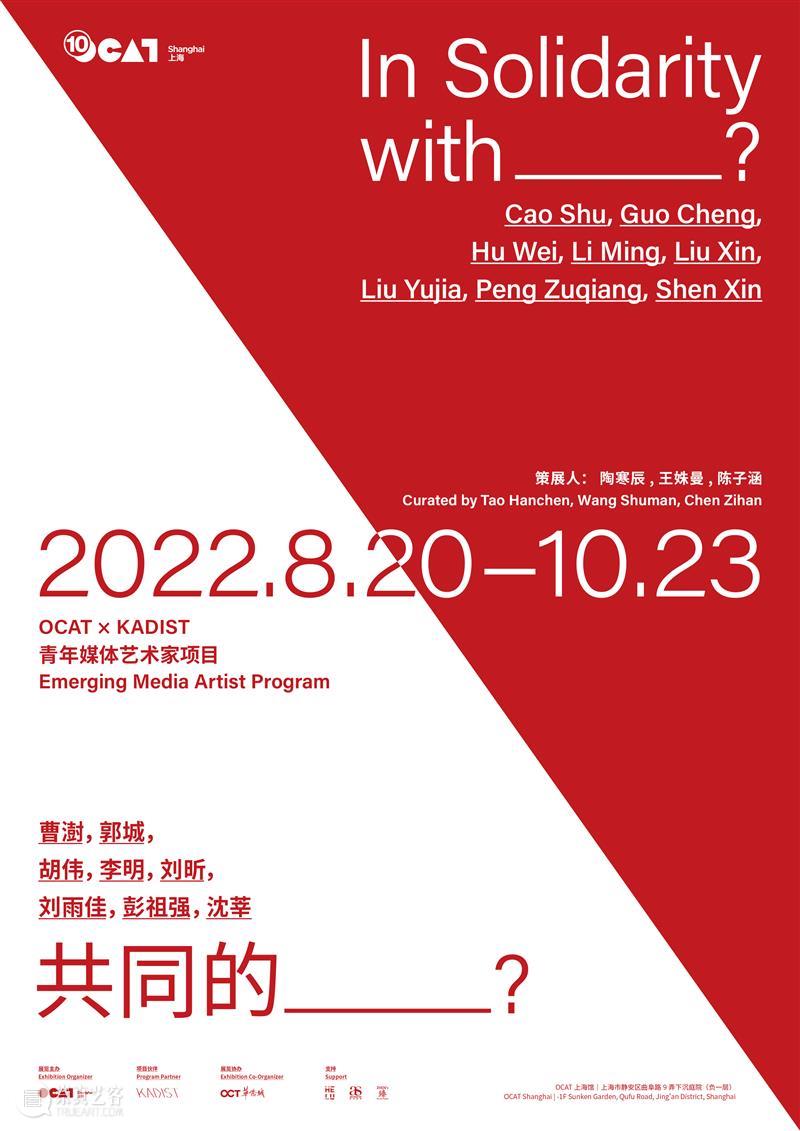
In Solidarity with____?
2022 "OCAT × KADIST
Emerging Media Artist Program" Exhibition
Artists: Cao Shu, Guo Cheng, Hu Wei, Li Ming, Liu Xin, Liu Yujia, Peng Zuqiang, Shen Xin
Curators: Tao Hanchen, Wang Shuman, Chen Zihan
Exhibition Period: August 20 - October 23, 2022
Venue:-1F Sunken Garden, Qufu Road, Jing'an District, Shanghai
Exhibition Organizer: OCAT Shanghai
Program Partner: KADIST
Exhibition Co-Organizer: OCT Land (Shanghai) Investment Ltd.
OCAT Shanghai is pleased to announce the group exhibition "In Solidarity with____?", the first chapter of the OCAT x KADIST Emerging Media Artist Program 2022. This exhibition marks the eighth edition of OCAT Shanghai’s annual Emerging Media Artist Program, a project that launched in 2013, and its second collaboration with KADIST to support artists from China working in media art. The eight exhibited artists were selected from nominations by eighty contemporary art professionals for their demonstration of creativity, and command for the language of media art across multiple dimensions of practice. During the exhibition, an international jury will award one of the artists with a short, fully-funded research residency at KADIST San Francisco in 2023.
ABOUT THE EXHIBITION
We live in a new media era constructed by artificial intelligence, algorithmic systems, blockchains and other technologies—one that promises to provide personalized experiences, promote decentralized autonomy, and envision the future of communities. In reality, however, the proliferation of digital communication on and through a limited set of mainstream platforms has led to convergent discourses in the public sphere. A distributed concept of decision-making is limited by divergent interests without regulation, and the specific meanings of "solidarity" have degenerated into ambiguous forms due to overuse and over-consumption. From a linguistic perspective, new media provides extra vehicles for the "mythological" system that transforms meaning into form to further dismantle the understanding of reality as "natural" when it is instead socially constructed.[1] Starting from this new normal, the exhibition posits three chapters that introduce the notion of "solidarity" from various dimensions (e.g. ontology, body ethics, ideology, etc.), revealing how the excessive meaning given to the term "solidarity" conceals a cognitive crisis.
A Total Mobilized Planet
<< Please swipe left to view more >>
Undeniably, the notion of solidarity feels more appealing in abstract than in concrete terms—solidarity unbound by any sort of conditions or territories and applicable in all dimensions, such as planetary dimensions mobilized by all forms of matter, energy, and planetary life (human and non-human).[2] The exhibition begins here, with atmospheric particles that encase planets striking human apparatuses under a computer-simulated "virtual oracle". Spaceships carrying human expeditions plummet downward, and energy resources extracted from the earth are transported upward to industrial cities. These concrete situations suggest that "solidarity" is confirmed by the existence of an abstract symbiosis among different species and substances, as well as one's perceived place in this symbiotic system. As philosopher Bruno Latour reminds us, "Not everything is political, perhaps, but politics gathers everything together."[3] In his view, humans are willing to live in a symbiotic relationship with natural objects outside of themselves because they have realized that nature serves only as a standard, a foil, a reserve, a resource, and a public dumping ground, in service to a politic that no longer exists.[4] The notion of "solidarity" is thus recalled, described, and self-referenced as a new political logic in order to redefine our respective interests and responsibilities under the planetary crisis.
The Instructed Collective
<< Please swipe left to view more >>
In Latour's view, concrete politics engenders abstract solidarity. However, does the reverse logic also stand? In other words, does abstract solidarity initiate specific forms of politics? Following this line of questioning, the exhibition moves from a planetary scale back to the territory of human societies, speculating on the meaning or forms of "solidarity" within concrete histories, communities, infrastructure, and living spaces. It reimagines "solidarity" as an occasional, organized gathering embedded in people's collective memory, more specifically in the connection between individuals, the public space, and communal life. When we try to unpack these composite images, we may realize what exists is not a collective memory of a moment but rather what critic and political activist Susan Sontag calls a "collective instruction".[5] Shared historical moments act as symbols to legitimize actions and instruct future generations. These symbols materialize "solidarity" in specific physical spaces, such as a heterogeneous frontier landscape, a redecorated radio station, a restricted housing unit, and an abandoned guest house with an ocean view. Moreover, physical space no longer represents the entirety of human society today but rather the interests of a few. It has been transformed into a "giant space station" since the moment the first astronauts began circling Earth, removing all social functions from their original position and putting them into the same orbit.[6] Information technology is an invisible "developer" in this orbit, producing a new common order in the cloud through a series of information governance technologies such as Skynet satellite systems, Internet security gateways, and big data tracking applications. These new experiences are still being introduced—with no actual anchor or reference, the "space station" hasn’t been able to land.
"Beside" The Bodies
<< Please swipe left to view more >>
This emergent common space "beside" the planet and collective field recalls the body in between—its form, perception, history, and subjective composition in a perpetual state of becoming. If "solidarity" is understood as a form of externalization, "beside" might be understood as more of an internal structure of "solidarity" that connects adjacent elements and complicates assumptions of inherent duality. As outlined by queer theorist Eve Sedgwick, "beside" comprises a wide range of relations including desiring, identifying, representing, repelling, paralleling, differentiating, rivaling, learning, twisting, and mimicking.[7] Revolving around performances of reproduction and spirituality, emotion and intellect, geography and economy, the bodies on screen aim to restore the complexities of coexisting "beside"—in relationship to a digital doppelganger, in communion with an erotic object, and showing empathy for those who share similar experiences. In this process, contradictions emerge simultaneously. Is the digital doppelganger a new life to be bred or a mechanical object to be reproduced? How can intimacy accommodate both trust and transgression? When empathy is shown for a similar experience, is it an effective demonstration? These contradictions point again to the necessity for reflecting on "solidarity" to reconstruct it into an inclusive, variable, current form, versus a general conception of "us vs. them."[8]
Today, in this moment, we are trying to understand the phenomenon of abstract solidarity as an act of political expediency. We feel that it is more urgent to inquire together into the specific causes of its abstraction and preserve an exclave for further questioning than continue denying that it exists.
Bibliography:
[1] Paul de Man, "Roland Barthes and the Limits of Structuralism," Yale French Studies 77 (1990): 182-183.
[2] Yuk Hui, "For a Planetary Thinking," E-flux Journal #114, December 2020, https://www.e-flux.com/journal/114/383940/n-a/.
[3] Bruno Latour, Politics of Nature -- How to Bring Sciences into Democracy, trans. Catherine Porter (Cambridge, MA: Harvard University Press: 2004), 53.
[4] ibid, 58.
[5] Susan Sontag, Regarding the Pain of Others, trans. Huang Canran (Shanghai: Shanghai Translations Publisher, 2018), 75-76.
[6] Jean Baudrillard, Transparency of Evil: Essays on Extreme Phenomena, Trans. Wang Qing (Northwestern University Press: 2019), p.36.
[7] Eve Sedgwick, Touching Feeling: Affect, Pedagogy, Performativity, (Duke University Press, 2003), 8.
[8] Chandra Talpade Mohanty, Feminism without Borders: Decolonizing Theory, Practicing Solidarity, (Durham & London: Duke University Press, 2003), 7.
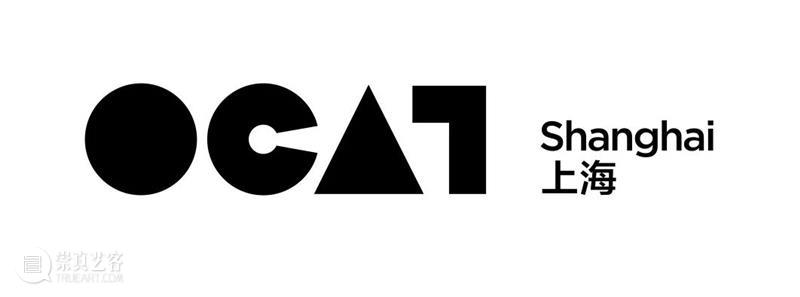
OCAT Shanghai is the first professional art institution focused on media art and architectural design in China. Located in the Suhe Creek area of Jing'an district, OCAT Shanghai aims to serve as a forward-looking, influential, socially-aware and interactive art institution through exhibitions, research, communication, public education, publications, and collections. Artist Zhang Peili is the current executive director of OCAT Shanghai.
OCAT Shanghai is the first branch of OCAT Museums to open outside Shenzhen. Inaugurated on September 29, 2012, it has since organized a series of influential academic exhibitions. The museum officially moved to its new location in October 2019 (-1F Sunken Garden, Qufu Road, Jing'an District), and has been open to the public with its inaugural exhibition in the same month.

KADIST is a non-profit contemporary art organization that believes artists make an important contribution to a progressive society through their artwork, which often addresses key issues of our time. Dedicated to exhibiting the work of artists represented in its collection, KADIST encourages this engagement and affirms contemporary art’s relevance within social discourse. Its local hubs in Paris and San Francisco organize exhibitions, physical and online programs, and host residencies. Supported by a global network of advisors, KADIST develops collaborations internationally including with leading museums, facilitating new connections across cultures and vibrant conversations about contemporary art and ideas. kadist.org
即将展出
OCAT x KADIST青年媒体艺术家年度项目展览单元
共同的____?
展期:2022年8月20日至10月23日
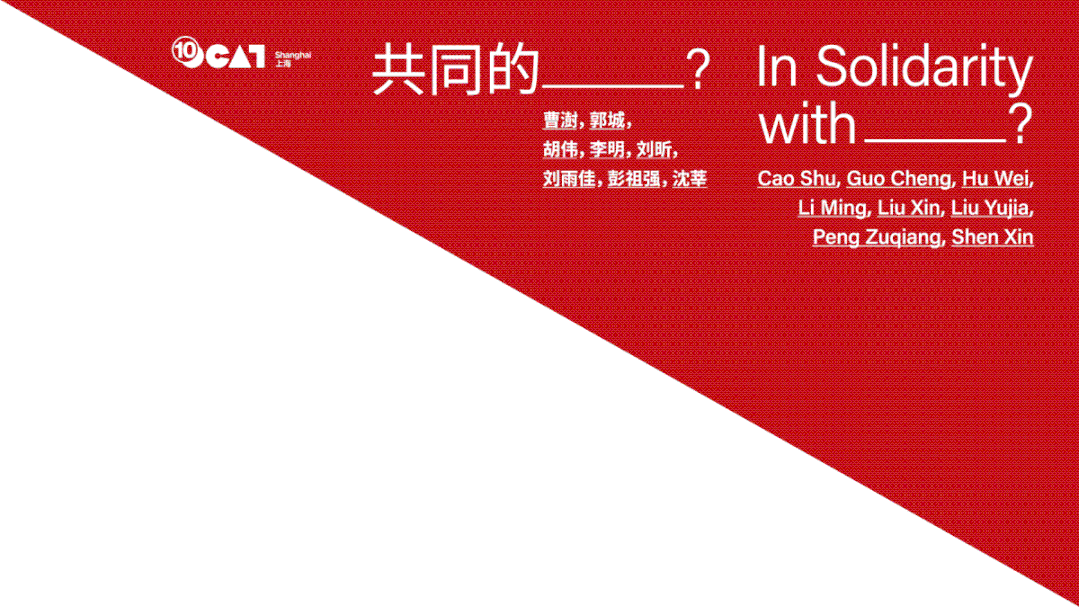
关于OCAT上海馆
参观时间 | Admission Hour
10:00-18:00 周二至周日(周一闭馆,节假日等特殊时期开放时间根据场馆公告而定)
最后入场时间:17:30
10:00-18:00 from Tuesday to Sunday (Closed Mondays except public holidays)
Last Entry 17:30
联系我们 | Contact us
Email: ocatshanghai@ocat.org.cn
Weibo: @OCAT上海馆
Instagram: @ocat__shanghai
Tel: 021-66085180, 021-66085119
地址 | Address:
上海市静安区曲阜路9弄下沉庭院,负一层(轨道交通8号线、12号线曲阜路站)
-1F Sunken Garden, Lane 9, Qufu Road, Shanghai (MTR Line 8 & 12 Qufu Road Station)
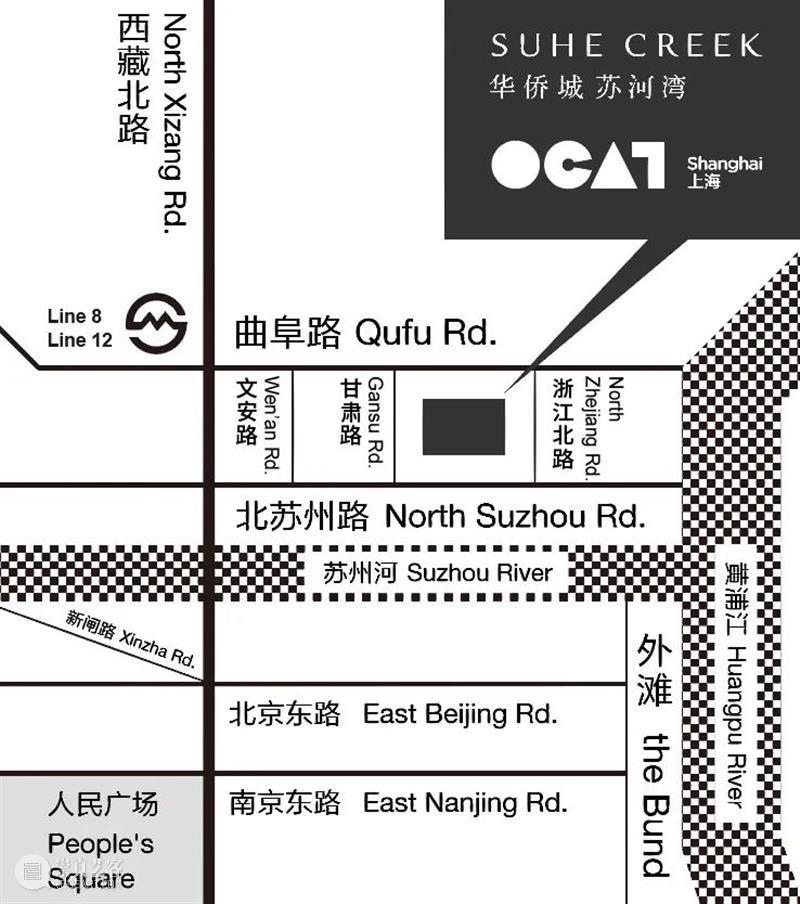


已展示全部
更多功能等你开启...

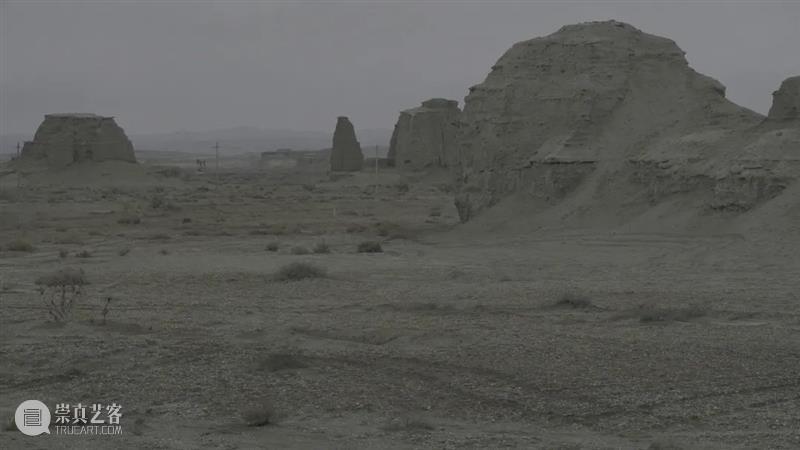

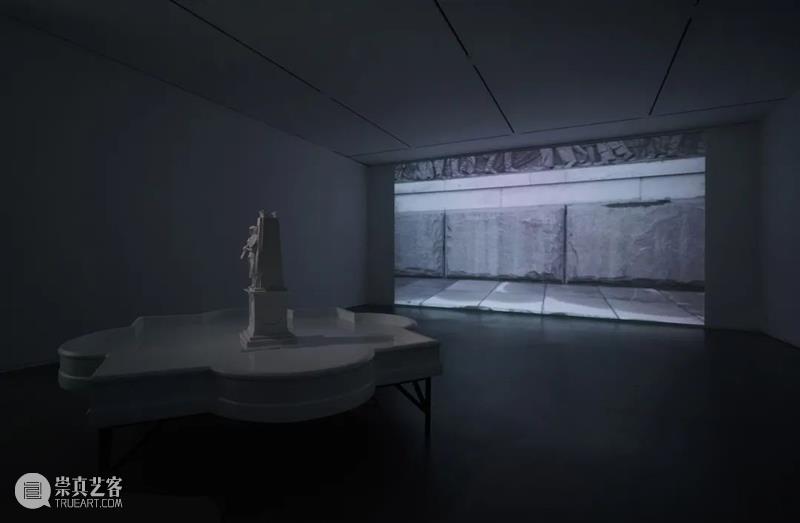

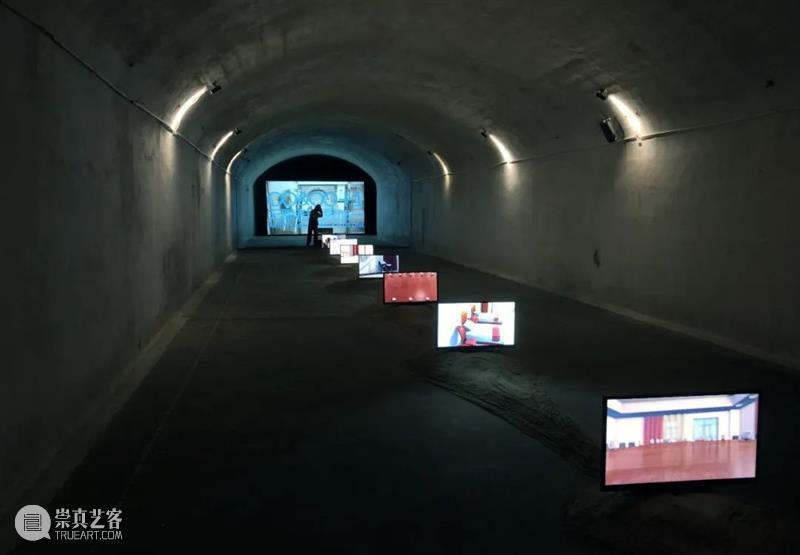

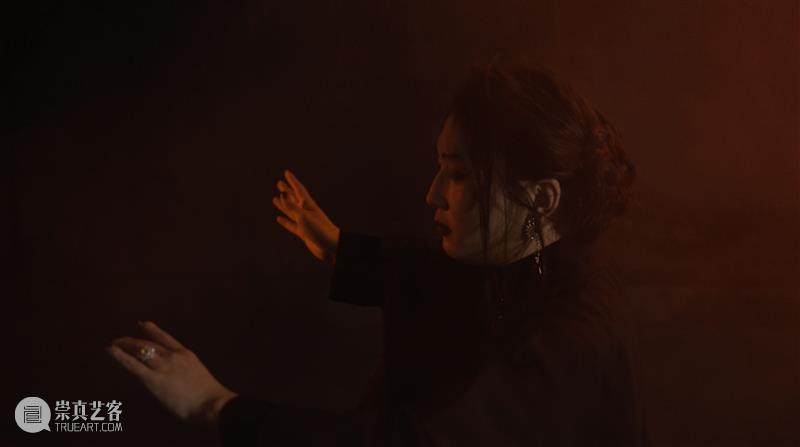
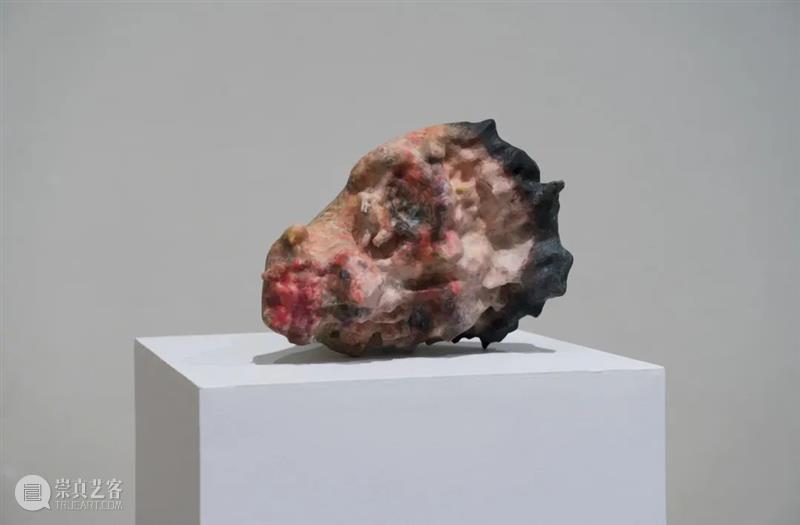







 分享
分享